HISTORY OF CARDIOVASC: SURGERY
History > Global Heart Valve Disease Day Webinar
| | | |  |
HISTORY OF CARDIOVASCULAR SURGERY
Milestones of Cardiac Surgery in Africa
1953: Jean Demirleau in Algeria performed a closed mitral valvotomy in Africa.
1958 The first open heart surgery (closure of ASD) was performed in Africa by Christiaan Barnard in Cape Town
1967 The first world-wide human heart transplantation was performed in Africa by Christiaan Barnard in Cape Town,
South Africa.
1960 First close (closed mitral valvotomy in Accra, Ghana by Charles Easmon
1960 The first closed mitral valvotomy in Ibadan, Nigeria.by John Weaver
1964 First open heart surgery (ASD closure by surface cooling, Accra, Ghana), West Africa by Charles Easmon.
1974 First open heart surgery in West Africa using the heart lung machine in Enugu, Nigeria by Magdi Yacoub
1978 First open heart surgery in Abidjan,Cote d‘Ivoire.by Dominique Metras
1980 The first close mitral valvotomy in Monrovia, Liberia by Charles Yankah
1989 Resuscitation of cardiac program in Ghana by Kwabena Frimpong-Boateng.
1992 The first open heart surgery in Dakar, Senegal by Mouhamadou N‘Diaye
1970 The first open heart surgery in Kampala, Uganda East Africa by Lindsay Grigg the first open heart surgeries
(closure of ASD in deep hypothermia and circulatory arrest)
1973 The first open heart surgery in Nairobi, Kenya, East Africa was performed Eddy Knight.
2002 The first open heart surgery, paediatric program in Asmara, Eritrea by Bolous Asfour and Andreas Urban
HISTORY OF CARDIAC SURGERY II
DEVELOPMENT OF HLM
Milestones
☺1937 First PDA ligation was performed by Thomas Streider – the patient died on the 4th postop. day
☺1938 Gross ligated a PDA successfully in a 1 year old girl. An era of surgery of cong heart dis.
☺ 1944 Crafoord and Nylin repaired coarctation of the aorta by resection and end to end anastomosis in Sweden
☺ 1944 Blalock (and Taussig) created a Subclavia-PA shunt to palliate a patient with TOF. This provided a hope for children and adults with cyanotic cong. heart disease
Ligation of Patent Ductus Arteriousus (PDA)
August 26, 1938, when Robert E. Gross of Boston, Massachusetts, successfully ligated a PDA.
It is largely unknown that in the same year and before Gross, Emil Karl Frey, a surgeon at the Medizinische Akademie in Dsseldorf, Germany, had already ligated a PDA successfully.
Milestones
☺ Attempts Using Closed Surgery
ADVANCES IN THE MANAGEMENT OF CONGENITAL HEART DISEASES
•Congenital heart surgery is very special. It is a profession that combines art, science and skill.
•Congenital heart surgery is a young specialty. It has been characterized by a history of innovation.
The 1950’s might be referred to as the “maverick era”. Since then huge advances have been made
Milestones
Closure of Atrial Septum Defect 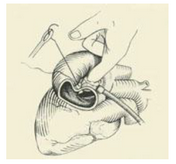 1952, Charles Baily successfully repaired a large septal defect in a thirty-eight-year-old woman by a method which he called “Atrio-septopexy”
1952, Charles Baily successfully repaired a large septal defect in a thirty-eight-year-old woman by a method which he called “Atrio-septopexy”
Closure of Atrial Septum Defect
In January 1952, Charles Baily successfully repaired a large septal defect in a thirty-eight-year-old woman by a method which he called “Atrio-septopexy” (left figure). He made an incision in the right atrial wall, inserted his finger through the hole to investigate the right atrium and the defect, and then sutured the right atrial wall to the rim of the defect. He used this technique in twenty patients total, fourteen of which had the secundum defect; the mortality rate was 14.3% -- an improvement on the alternative methods which had been used during the past 4 years.
Total Cardiac Inflow Occlusion and Hypothermia
It was becoming evident that progression in Cardiac Surgery could only be obtained through the development of methods which allowed direct vision and a dry field. Two promising techniques at the time were total cardiac inflow occlusion and hypothermia
Total cardiac inflow occlusion
1940 Richard Varco, University of Minnesota: Total cardiac inflow occlusion.
Time restriction remained an obstacle for this method.
Development of Hypothermia
Experimental Deep Hypothermia
1951:
W.G. Bigelow, a surgeon at the University
of Toronto, hypothermia to obtain direct
vision in intracardiac
surgeries. His successful results, on 13 monkeys in 1951, were a promising starting point.
Milestones
1952-1954
–
A concept of deep hypothermia was introduced
A patient with ASD was slowly cooled
down with refrigeration blankets to 28 degree centigrade. They then opened the chest, occluded the vena cava, opened the right atrium, and closed the ASD.
Milestones
First intracardiac operation in deep hypothermia and circulatory arrest without heart lung machine
First intracardiac operation in deep hypothermia and circulatory arrest without heart lung machine
September 1952: Richard Varco and John Lewis, University of Minnesota.
The first intracardiac operation performed in a dry operating
field under direct vision without heart lung machine.
Lewis and colleagues operated on 60 patients with atrial septal defect using
deep hypothermia and 54 survived (1952 – 1954).
The first successful open heart surgery with a heart lung machine
In May 6, 1953, a major breakthrough in heart surgery was achieved when John H. Gibbon, at the Jefferson Medical College in Pennsylvania, performed the first successful open heart surgery on an eighteen-year-old girl with an atrial septal defect. For this operation he used the Gibbon-IBM heart lung machine, developed over the past decade and a half, with the help of engineers from IBM in New York.
The first successful open heart surgery with a heart lung machine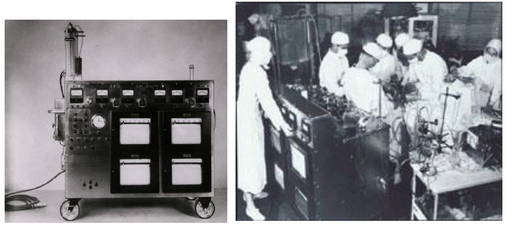
May 6, 1953 at Jefferson Medical College Hospital, Dr. John Heysham Gibbon, Jr. used the Heart-lung machine, Model II, 1951 to close ASD in a 18 year old Cecelia Bavolek. Art/Photo Collection, AG-054
Mayo-Gibbon
heart-lung machine,
1958
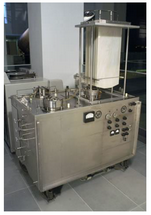 1955: Dr. Earl Wood and Dr. John Kirklin, working with engineers from the
Custom Engineering and Development Company of St Louis, Missouri, produced this
more commercially viable version in 1955.
1955: Dr. Earl Wood and Dr. John Kirklin, working with engineers from the
Custom Engineering and Development Company of St Louis, Missouri, produced this
more commercially viable version in 1955.
It was also used at London's Middlesex Hospital
It was also used at London's Middlesex Hospital
Modification of the heart-lung
machine
developed by the surgeon John Gibbon
Milestones
Early
1954 –
Pessimism was universal
Open
heart surgery –
“Great concept but sick human heart could
not tolerate it !!!”
Use of Cross Circulation
1954 – Walton Lillehi and associates operated on a child with VSD using controlled cross-circulation,
University of Minnesota, USA.
A total of 47 pts were operated using this technique.
63% of these pts were alive 30 years later.
Milestones
Development of the Bubble Oxygenator
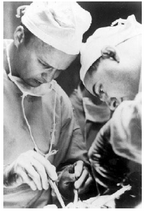 1955
Richard De Wall of University of Minnesota, together with Walton Lillehei
1955
Richard De Wall of University of Minnesota, together with Walton Lillehei
Development of the Bubble Oxygenator
The device was an instant success
and was used throughout the world because it was inexpensive, easy to assemble,
and heat sterilizable. Throughout the years to come, oxygenator designs
became more advanced, eventually leading to the development of membrane
oxygenator and hollow fiber oxygenators
Milestones

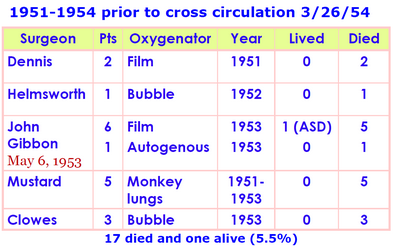
Milestones
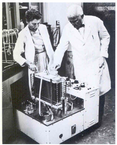 John Kirklin and colleagues used the modification of the Gibbon oxygenator and began to operate on intracardiac malformations successfully
John Kirklin and colleagues used the modification of the Gibbon oxygenator and began to operate on intracardiac malformations successfully
History of Cardiac Surgery
1896
Ludwig Rehn successfully stitched a wound in the heart..
1912
Ludwig Rehn und Ferdinand Sauerbruch performed the first successful pericardectomy for a constricting pericarditis..
1924
Martin Kirschner performed the first successful pulmonary embolectomy using the technique developed in 1907 by Friedrich Trendelenburg.
1923/25
Elliott Culter und Samuel Levine (cardiologist) performed in 1923 transventricular and Souttar in 1925 Soutar transatrial (auricle) mitral valve valvotomy .
1929
First heart catheterization a self experiment by Werner Forssmann.
1931
Ferdinand Sauerbruch successfully operated on a right ventricular aneurysm..
1938
Emil Frey performed the first surgical ligation of a patent Ductus arteriosus Botalli.
1944
Clarence Crafoord performed the first successful repair of aortic coarctation by resection and end to end anastomosis.
1944
Alfred Blalock and Helen Taussig (cardiologist) performed the first left Art. subclavia to Art. pulmonalis shunt to improve the oxygen saturation in a child with tetralogy of Fallot.
1948
Thomas Sellors and Russell Brock independently performed transventricular pulmonary valvotomy for congenital pulmonary stenosis.
1948
Robert Gross und Tyge Sondergaard performed atrial septal defect (closed technique).
1950
Wilfred Bigelow developed a technique for cerebral protection during circulatory arrest.
1952/53
John Lewis performed the first open congenital heart surgery in hypothermia.
1953
John Gibbon developed a heart lung machine for open heart closure of atrial septal defect.
1954
Äke Senning und Clarence Crafoord.resected atrial myxoma in extracorporal circulation .
1954
Walton Lillehei, father of open heart surgery, used the Cross-Circulation technique to correct tetralogy of Fallot-Tetralogy in a child.The circulation of the parent was connected to that of the child to maintain the circulation when the child’s heart was arrested during the open heart operation.
1958
Äke Senning implanted the first heart pace maker.
1960
Dwight Harken performed the first aortic valve replacement with a cage ball prosthesis.
1961
Albert Starr performed the first mitral valve replacement with a cage ball prosthesis (Starr-Edwards Valve).
1962
Frank Mason Sones performed the first selective coronary angiography during a heart catheterization..
1963
Hans Borst performed aortic arch operation in hypothermia and circulatory arrest.
1967
Rene Favalaro performed coronary artery revascularisation with a coronary artery vein graft (CABG) and Vasilii Kolessov with Art. mammaria.
graft.
1967
Adrian Kantrowitz performed the first intra aortic balloon pump (IABP) counterpulsation for treating patients in cardiogenic shock.
1967
Christiaan Barnard performed the first human orthotopic heart transplantation.
1977
Andreas Gruentzig performed the first coronary balloon angioplasty.
1981
Bruce Reitz performed the first heart lung transplantation.
History of Heart Halve Surgery
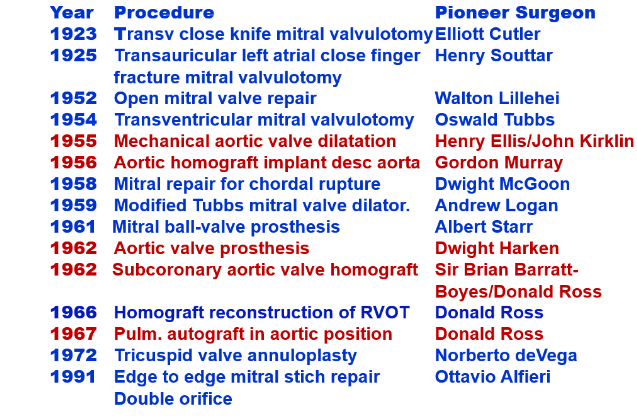
Surgery of Endocarditis
Historical Developments

History of Transcatheter Heart Valve
Repair and Implantation

